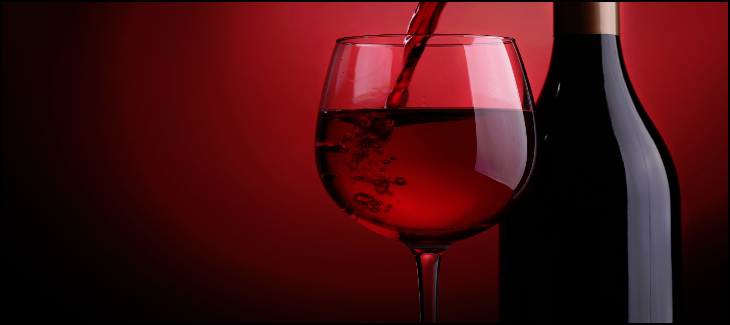BARBERA
This is Italy’s second most planted grape and found mostly in the Alba and Asti regions. Notes of tart cherry, minerality, and violet are found throughout the palate. It is also grown in the United States, where flavors of strawberry, plum, vanilla, nutmeg and anise are prevalent.
CABERNET FRANC
Cabernet Franc is often used in blends but is also popular as a single varietal. It is predominately a single varietal in the Loire valley of France, where it can simple be called Cabernet. It is lighter than Cabernet Sauvignon, and in blends adds a peppery component. Additional aromas can include tobacco, raspberry, bell pepper, cassis, and sometimes even violets.
CARMENERE
This red varietal disappeared from European vineyards in the mid-19th century. It reappeared in Chile, where it had been marketed as Merlot. Only in the late 1990s did winemakers, visiting from France, determine that what was “Merlot” throughout much of Chile in truth was Carmenere. It has now become Chile’s signature grape. The flavor profile of Carmenere is red fruits, chocolate, coffee, smoke, and spice.
GAMAY
This is the Beaujolais grape, and please don’t automatically think of Beaujolais Nouveau. While Gamay is often made to be consumed quite young, this is not always the case. The Gamay grape has flavors of raspberry, cherry and strawberry. In some cases, as with the Cru Beaujolais, it can taste very much like a lighter style of Pinot Noir.
GRENACHE/GARNACHA
Old Vine Grenache makes some of the greatest red wines in the old World. It is an important grape in the making of Chateauneuf-du-Pape, Gigondas, and Cotes-du-Rhone in France. It is the main grape of Spanish Priorat, a rich concentrated spicy red. Grenache is very big, fruity and spicy; bold-flavored that could be compared to a lighter style of Syrah.
MALBEC
Malbec has risen in popularity over the years. Argentina has revived the grape, which previously had been used mainly as a blending grape in Bordeaux. Argentine Malbecs are richly fruity, with nuances of mulberries, blackberries, and spice. Cohors in southwest France also produces a bit of Malbec, which is a lighter wine, with notes of blackberry and minerality.
MOURVÈDRE/MATARO
By itself, Mourvèdre is a medium-bodied, lightly spiced wine with notes of cherry. It is normally found as a blending grape alongside Shiraz and Grenache in France and Australia, but single varietal wines can be found.
NEBBIOLO
This Italian grape is the grape used in Barolo and Barbaresco wines. The grape has aromas of black fruits, cherry pie, dried plum, truffles, and leather, oftentimes with a floral note. Despite both wines being made of Nebbiolo, there are some differences between Borolo and Barbaresco. Barolo is known to be more tannic and rich while Barbarescos are more graceful and approachable.
PETITE SIRAH
The origin of the Petite Sirah found in California wasn’t clear until the 1970s. Grape DNA showed that Petite Sirah is a mutant of three grape varieties: durif, peloursin, and true Syrah itself. The grape has dark berry and plum fruit characteristics, along with a black pepper spice. It is often blended with Zinfandel for added complexity, structure, and to tone down the tendency of Zinfandels toward “jammy” fruit.
PINOTAGE
This is South Africa’s signature grape. It was bred there in 1925 as a cross between Pinot Noir and Cinsaut. Pinotage tends to take on an earthier flavor profile with notes of berries, smoke and every once in a while, a little funk (but the good kind of funk).
SANGIOVESE
Grown largely in Italy, Sangiovese is the primary component of Chianti and Brunello. It has nuances of baked cherry, anise, and tobacco. Super Tuscans often blend the grape with Cabernet Sauvignon. Some styles of Sangiovese will emphasize herbal and bitter cherry notes while others stress plum and mulberry, with notes of vanilla and spice.
TEMPRANILLO
Indigenous to Spain, this grape is found in Rioja and Ribera Del Duero. The flavor profile consists mainly of blackberry, raspberry, plum, vanilla, leather, and tobacco. The label will tell you how long the wine has been aged: Crianza Reds are aged 2 years, 6 months in oak. Reserva Reds are aged 3 years, 1 year in oak. Gran Reserva is aged a minimum of 5 years, 18 months in oak.
ZINFANDELS
NOT THE PINK STUFF. Red Zinfandel is grown in California and Italy. Zinfandels are big, robust, fruity wines, with nuances of cherry, raspberry, strawberry jam, and spice. In Italy, it is known as Primativo and tends to be a bit earthy with notes of plum and cherry. California Zinfandels from Dry Creek are racy and laden with raspberry. Those from Amador tend to be thick and jammy while Zinfandels from Napa are lush with ripe, sweet black cherry flavors.


